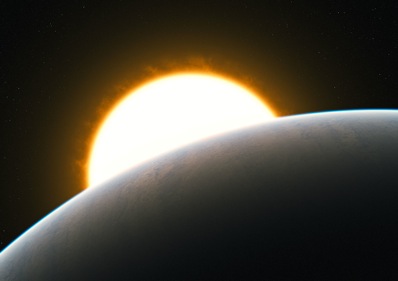



|

|

Superstorm rages
on exoplanet
DR EMILY BALDWIN
ASTRONOMY NOW
Posted: 23 June 2010


High-precision observations have allowed astronomers to make the first measurements of a storm raging on an exoplanet, as well as compute the planet's orbital speed and mass.
The planet, HD209458b, was the first transiting exoplanet to be discovered. Every 3.5 days the planet passes in front of its parent star, taking three hours to make the transit. During this time, the light emitted from the star is temporarily blocked, but a tiny fraction filters through the planet's atmosphere, leaving an imprint.
 Astronomers have studied the hot-Jupiter exoplanet H209458b, finding carbon monoxide gas streaming at enormous speed from the extremely hot day side to the cooler night side of the planet. Image: ESO/L. Calçada. Astronomers have studied the hot-Jupiter exoplanet H209458b, finding carbon monoxide gas streaming at enormous speed from the extremely hot day side to the cooler night side of the planet. Image: ESO/L. Calçada.
Using the powerful CRIRES spectrograph on ESO's Very Large Telescope, astronomers from the Leiden University, the Netherlands Institute for Space Research (SRON), and MIT in the United States, probed these fingerprints in exquisite detail, determining the position of carbon monoxide lines with a precision of 1 part in 100,000. “This high precision allows us to measure the velocity of the carbon monoxide gas for the first time using the Doppler effect,” says team member Remco de Kok.
“HD209458b is definitely not a place for the faint-hearted. By studying the poisonous carbon monoxide gas with great accuracy we found evidence for a super wind, blowing at a speed of 5,000 to 10,000 kilmetres per hour‚” adds team leader Ignas Snellen.
The ferocious winds are due to the extreme temperature differences between the dayside and nightside of the planet, which, at just one-twentieth the Earth-Sun distance orbits with one face locked towards its host. “On Earth, big temperature differences inevitably lead to fierce winds, and as our new measurements reveal, the situation is no different on HD209458b,” says Simon Albrecht.
The astronomers also measured the velocity of the planet as it careered around its Sun-like star, enabling them to determine the planet's mass – some 60 percent the mass of Jupiter. “In general, the mass of an exoplanet is determined by measuring the wobble of the star and assuming a mass for the star, according to theory,” explains Ernst de Mooij. “Here, we have been able to measure the motion of the planet as well, and thus determine both the mass of the star and of the planet.”
Furthermore, the astronomers found that H209458b has a carbon rich atmosphere, just like Jupiter and Saturn. “This could indicate that it was formed in the same way,” says Snellen. “In the future, astronomers may be able to use this type of observation to study the atmospheres of Earth-like planets, to determine whether life also exists elsewhere in the Universe.”
|

|

|

|
|



